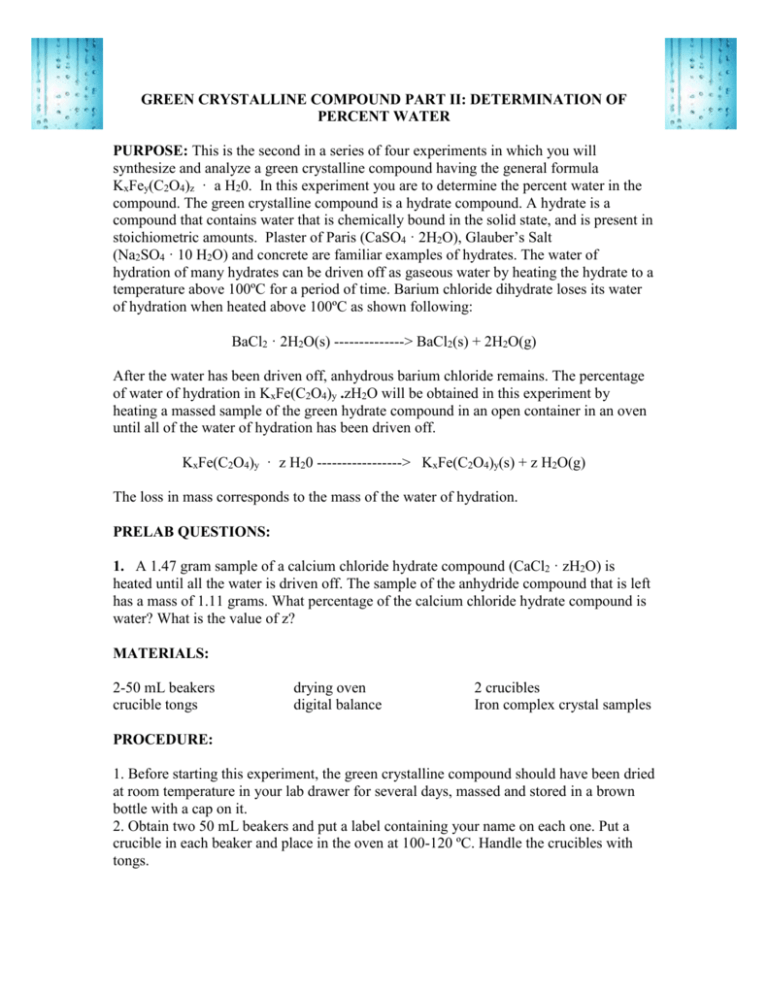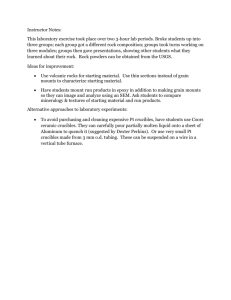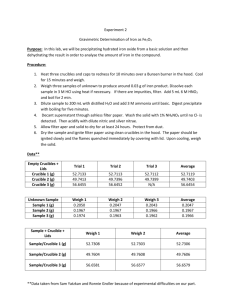green crystalline compound part ii: determination of - Parkway C-2
advertisement

GREEN CRYSTALLINE COMPOUND PART II: DETERMINATION OF PERCENT WATER PURPOSE: This is the second in a series of four experiments in which you will synthesize and analyze a green crystalline compound having the general formula KxFey(C2O4)z · a H20. In this experiment you are to determine the percent water in the compound. The green crystalline compound is a hydrate compound. A hydrate is a compound that contains water that is chemically bound in the solid state, and is present in stoichiometric amounts. Plaster of Paris (CaSO4 · 2H2O), Glauber’s Salt (Na2SO4 · 10 H2O) and concrete are familiar examples of hydrates. The water of hydration of many hydrates can be driven off as gaseous water by heating the hydrate to a temperature above 100ºC for a period of time. Barium chloride dihydrate loses its water of hydration when heated above 100ºC as shown following: BaCl2 · 2H2O(s) --------------> BaCl2(s) + 2H2O(g) After the water has been driven off, anhydrous barium chloride remains. The percentage of water of hydration in KxFe(C2O4)y .zH2O will be obtained in this experiment by heating a massed sample of the green hydrate compound in an open container in an oven until all of the water of hydration has been driven off. KxFe(C2O4)y · z H20 -----------------> KxFe(C2O4)y(s) + z H2O(g) The loss in mass corresponds to the mass of the water of hydration. PRELAB QUESTIONS: 1. A 1.47 gram sample of a calcium chloride hydrate compound (CaCl2 · zH2O) is heated until all the water is driven off. The sample of the anhydride compound that is left has a mass of 1.11 grams. What percentage of the calcium chloride hydrate compound is water? What is the value of z? MATERIALS: 2-50 mL beakers crucible tongs drying oven digital balance 2 crucibles Iron complex crystal samples PROCEDURE: 1. Before starting this experiment, the green crystalline compound should have been dried at room temperature in your lab drawer for several days, massed and stored in a brown bottle with a cap on it. 2. Obtain two 50 mL beakers and put a label containing your name on each one. Put a crucible in each beaker and place in the oven at 100-120 ºC. Handle the crucibles with tongs. 3. Allow the crucibles and beakers to cool for twenty minutes. Convection currents created when hot objects are put on a balance can affect mass measurements. 4. Determine the masses of the empty crucibles and record these and all other masses in this experiment to the nearest 0.001g. 5. Transfer between 1.000 and 1.200 grams of the green crystalline compound into each crucible. Mass the crucibles and crystals, and use the same balance you used in measuring the masses of the empty crucibles. 6. Record the masses of the crucibles and crystals, and subtract the masses of the crucibles in each sample to get the masses of the crystals before they are heated. 7. Put the crucibles containing the crystals into the 50 mL beakers and heat for 45 minutes in the oven at 110-120 ºC. Do not leave the crystals in the oven for a longer period of time or heat at a higher temperature, or the compound may decompose and turn brown. 8. Take the beakers, crucibles and crystals out of the oven and let them cool. Mass the crucibles and crystals and record the masses on your data sheet. 9. Return the crucibles with the green crystalline compound to the oven and heat for 30 more minutes. Follow this by cooling and massing. Repeat this process until the crucibles and remaining crystals have a constant mass, or until the class period is complete. 10. Calculate the decrease in mass upon heating for each sample and attribute this loss in mass to the water of hydration. Obtain the percent water of hydration for each sample, and compute the average for the two samples. 11. After the final massing, discard the anhydrous salt in the waste container, clean the crucibles, and put the brown bottles with your crystals (and caps on them) back into the lab drawer and lock. 12. YOU WILL BE GRADED ON THE ACCURACY OF YOUR AVERAGE PERCENT OF WATER. DATA AND CALCULATIONS: Include the following for both samples 1 and 2 in the data portion of your lab write up: Mass of crucible, mass of crucible and crystals before heating, mass of crystals before heating, mass of crucible and crystals after first heating, mass of crucible and crystals after second heating, mass of water, percent of water, average percent of water CONCLUSIONS: 1. Why is it essential to heat the beakers and crucibles before actually adding the crystal to them for subsequent heatings? 2. Why should successive heatings be done on the green crystalline compound in this experiment until the compound comes to a constant mass? 3. What is the greatest contributor to experimental error in this laboratory? How could we have corrected this? 4. Were there any visual indications that your hydrate did in fact lose water?








